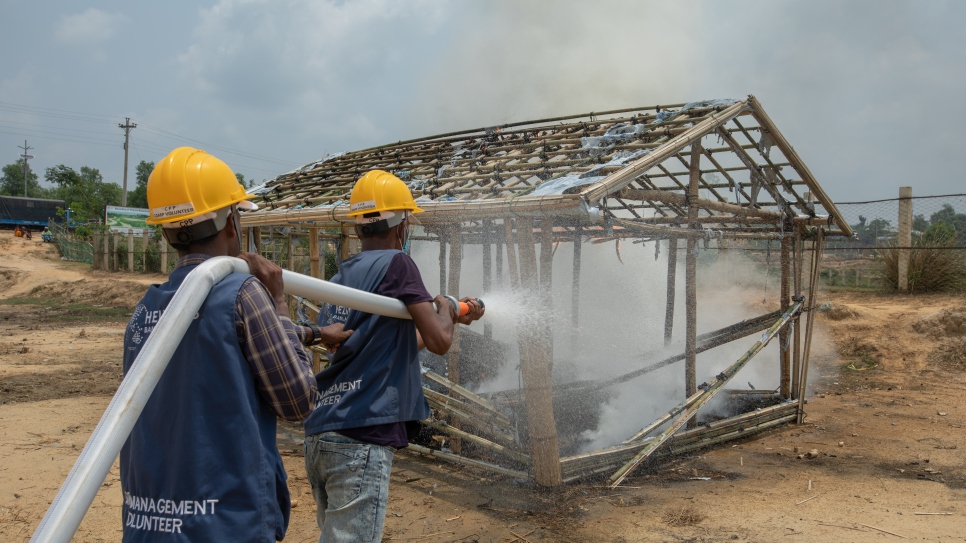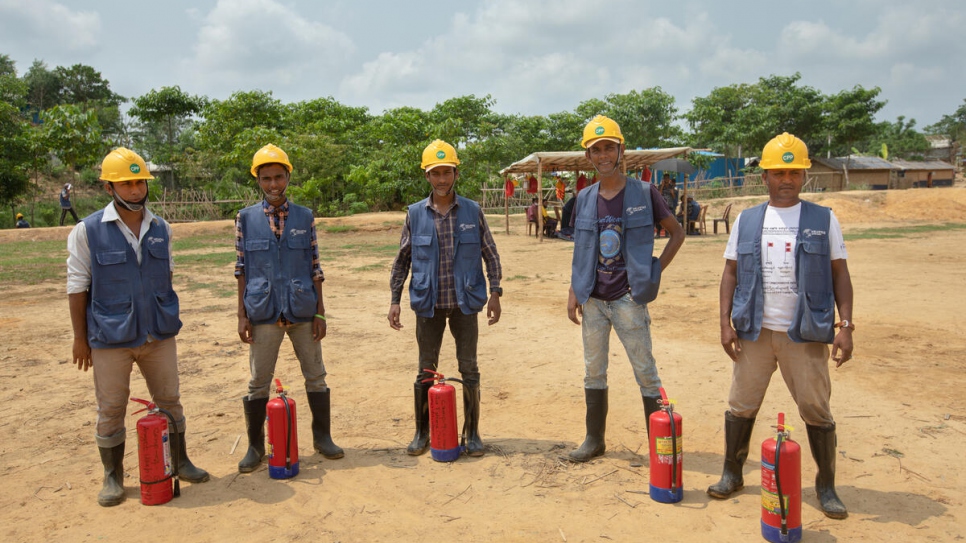Rohingya refugees lead response to fire threat in Bangladesh camps
Trained refugee volunteers are the first line of defence against the frequent fires that tear through camps in the dry season.
Volunteer fire fighter Mohammed Yasin takes part in a training drill at Kutupalong camp.
© UNHCR/Kamrul Hasan
First, a hole appears in the shelter’s tarpaulin roof, then flames and billowing black smoke. In less than a minute, the tarpaulin has melted completely, and the entire bamboo structure is ablaze.
In the dry season that lasts from December until April in southern Bangladesh, fires like this one are an ever-present threat in Kutupalong – the mega camp that sprang up in August 2017 when more than 730,000 Rohingya fled Myanmar to Bangladesh in a matter of weeks.
The government of Bangladesh welcomed the Rohingya but has ensured the temporary nature of the camps with restrictions on the types of building materials refugees and aid agencies can use. As a result, virtually everything in Kutapalong, from shelters to learning centres to walkways, is made from bamboo and tarpaulin, both of which are highly flammable. In addition, the camps are among the most densely populated places in the world with very little space between shelters to act as a natural fire break. In 2021, over 150 fires were reported, the largest of which killed at least 15 people and burned down some 10,000 shelters.
"Our people are afraid of fire."
Fortunately, this one is part of a training drill, and refugee volunteers are standing by to put it out, first with a hose attached to a small three-wheeled fire truck, and then with fire extinguishers. They use hand-powered water pumps attached to backpacks to extinguish the last few embers.
“Our people are afraid of fire,” says, Mohammed Yasin, 35, one of the volunteers taking part in the training. “They can break out at any time; we always live in fear.”
Both Bangladeshis and refugees are exposed to “one of the most disaster-prone calendars” in the world, according to Mohamed Othman, who heads up disaster response for UNHCR, the UN Refugee Agency, in Cox’s Bazar. The fire risk in the dry season is followed by the risk of flooding and landslides in the cyclone and monsoon seasons.
“The nature of the settlements, global climate change, the disaster calendar – all of these things add to the risks of emergencies, which is why we are focusing on preparedness and providing refugees with the tools to respond quickly when a fire or a flood happens,” Othman explains.
The main responders to those emergencies are trained refugee volunteers like Yasin. “This is one of the few humanitarian operations in the world where refugees are leading the emergency response,” says Othman. “They’re the first responders. They are protecting their families and their communities.”
The three-wheeled fire trucks, similar to the “tomtoms” that are the main form of transport in this part of Bangladesh, are a new tool for the volunteer fire-fighters. The small vehicles are better suited than traditional fire trucks to the narrow paths that criss-cross the camps. However, some areas are only accessible on foot.
“We can’t reach all the places where fires break out in time,” says Yasin, who has been working as a Safety Unit Volunteer for the past four years, fighting fires in the dry season and forming part of a cyclone response team in the rainy season. “When we get there, some of the shelters have already burned down.”
Daniel Graham, a technical specialist with Helvetas – a partner organization of UNHCR – who is supervising the training, describes the three-wheelers as one part of a multi-layered response.
“We burn four shelters every day for training,” he explains, adding that a total of 3,500 volunteers will be trained to use the mini-fire trucks, two of which have been delivered to each of the camps.
Each block of each camp has several volunteers like Yasin who are equipped with a fire extinguisher, a helmet and some rubber boots.
The blocks also have fire stands with buckets and sand but so far, only seven of the camps have water tanks that can be used by anyone to collect water for dousing a fire before it gets out of control.
Othman said UNHCR and partners plan to install 50 water tanks in each camp. So far, the authorities have approved the installation of 15 per camp. “We hope after installing those, we will be allowed to add the remaining 35 gradually,” he added.
The volunteers, about a third of whom are women, are trained on how to safely put out a blaze, as well as how to rapidly dismantle shelters surrounding one that is burning to prevent fires from spreading.
Asked why he continues volunteering, despite the risks, Yasin says simply: “These are my people, they are very close to my heart. It feels great to save their lives, and it also saves my life too.”





